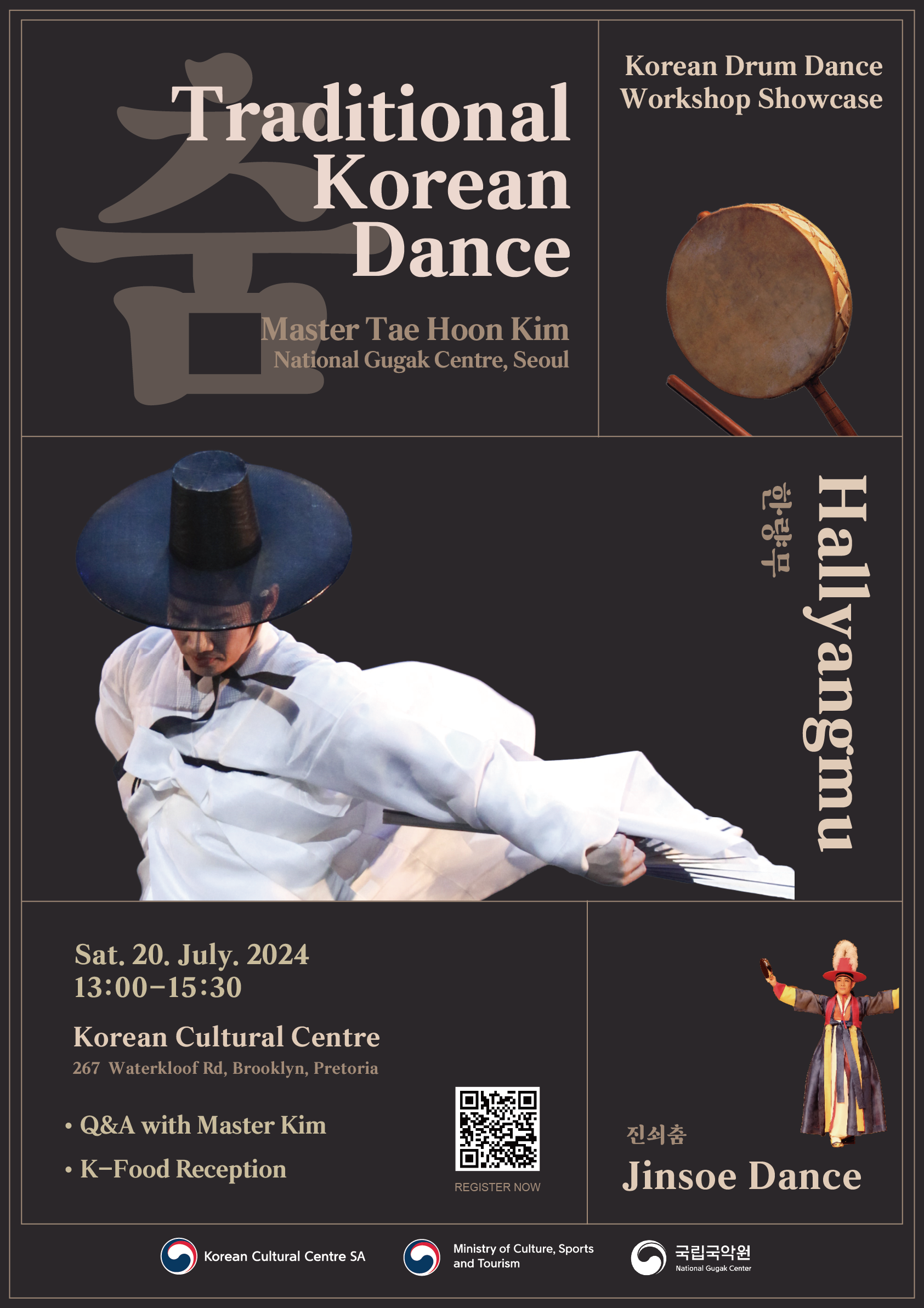TRADITIONAL KOREAN DANCE

Saturday, 20 July 2024
13:00-15:30
Korean Cultural Centre SA
267 Waterkloof Road, Brooklyn, Pretoria
Join us for an extraordinary afternoon immersed in the captivating rhythms and movements of traditional Korean dance.
The Korean Cultural Centre SA is thrilled to present an enchanting event showcasing the rich heritage of Korean performing arts on Saturday, 20 July 2024.
Delve into the beauty and artistry of Korean dance with a diverse programme that promises to enthrall and educate.
*The event will also feature a showcase of the TRADITIONAL KOREAN DANCE WORKSHOP.
PROGRAMME
• Korean Drum Dance Workshop Showcase
• Hallyangmu (Prodigal Man Dance)
• Jinsoe Dance (Kkwaenggwari Gong Dance)
• Q&A with Master Kim
• K-Food Reception
Hallyangmu (Prodigal Man Dance)
During the Joseon Dynasty, the term hallyang, or “prodigal men,” was applied to noblemen who did not hold office and therefore did not work for money, but simply idled away their lives enjoying various entertainments. Today, it also metaphorically denotes those who spend extravagantly and enjoy fully. Hallyang is one of the most popular characters in the traditional performing arts of Korea.
The Prodigal Man Dance is a performance dance in nine acts with a total of seven characters. The entire story is conveyed through dance alone without any dialogue, and each character has their own distinctive dance style to convey their personality and motives.
The performance tells the story of a wanton nobleman who is enjoying his time with a woman when a Buddhist monk walks by and falls in love with the woman at first sight. The monk tries to win the woman’s favor through an impressive dance and is successful. The woman betrays the aristocrat and follows the monk. The story is a comedic satire of depraved noblemen, monks who break their vows, unprincipled women, and lazy government officials.
It is uncertain when this dance was first performed, but it is said to have been popular at female entertainer parlors, following the start of the Japanese colonial period (1910-1945). Within Korean dance tradition, the Prodigal Man Dance is a rare example of a silent dramatic performance.
(Source: National Gugak Center, Academy of Korean Studies)
Jinsoe Dance (Kkwaenggwari Gong Dance)
“Jin-soe” refers to the kkwaenggwari, a traditional Korean percussion instrument, and represents the finest gong, aptly termed the “genuine gong.” The “Jin-soe Dance” is a captivating performance where the dancer expertly strikes the gong, creating sounds that are believed to summon various deities and ward off evil spirits. This dance has its roots in the Joseon Dynasty, typically performed during grand celebrations or royal banquets. On such occasions, the king would invite local governors to partake in the dance. It's a dance that powerfully conveys masculinity, blending discipline, spirited energy, and dynamism.
(Source: National Gugak Center)
TAE HOON KIM
• Member of the Korean National Gugak Center Dance Company
• National Intangible Cultural Property Cheoyongmu Completionist
• Seoul Metropolitan Intangible Cultural Property Hanrangmu Completionist
DATE
Saturday, 20 July 2024
TIME
13:00-15:30
VENUE
Korean Cultural Centre SA
267 Waterkloof Road, Brooklyn, Pretoria
REGISTRATION
https://forms.gle/xiL9siiJcsaDVCHr6 *required
For enquiries, please contact:
012 001 9204 | kccsa@korea.kr
Don't miss the opportunity to witness such rare and unique performances, and gain insights into the intricacies of Korean dance from Master Kim, a distinguished member of the Korean National Gugak Center Dance Company!
This event is organized in partnership with the National Gugak Center of Korea.
- attached file
